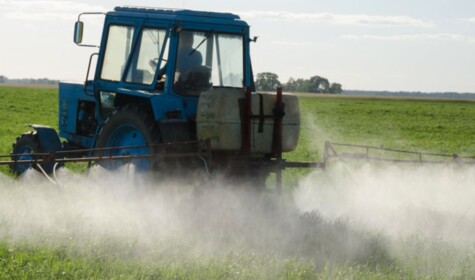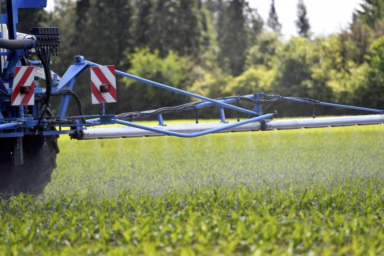A new study, published on 27th January in the journal Environmental Health Perspectives, conducted by an international team of scientists led by Dr Michael Antoniou of Kings College London, found that exposure to glyphosate and its commercial Roundup formulation, can disrupt the function of the gut microbiome (bacteria and fungi) and internal body systems with potentially serious effects on human health.
In controlled laboratory animal experiments, glyphosate was found to alter the composition, and more importantly, the biochemical function of the gut microbiome by the same mechanism through which the chemical acts to kill weeds (inhibition of the shikimate biochemical pathway), even at doses claimed to be safe by the regulators. Roundup was also shown to be more toxic than glyphosate alone, underpinning existing evidence that the additional substances present in commercial products, collectively known as ‘adjuvants’, are not ‘inert’ as claimed by its manufacturers and regulators but highly toxic in their own right.
In-depth biochemical analysis of both the gut and the blood of the test animals showed that they were put under ‘oxidative stress’, a highly damaging process, by glyphosate and to a greater degree by Roundup.
From my reading, this research appears to go a long way towards vindicating the conclusions of the many organisations and individuals throughout the world who were convinced from the very beginning that it would be unlikely in the extreme that this herbicide, an agricultural poison which has the capacity to kill all green plant material except that which has been genetically modified to be tolerant to it, would not have adverse effects on the human health.
The new research builds on the work published in September 2012 by Professor Gilles-Eric Séralini, who showed that exposure to an extremely low dose of Roundup in rats over two years led to a highly statistically significant disturbance in the animals’ physiology, and most dramatically an increase to breast tumour incidence.
The SFT organised a London press release to highlight the findings of the Séralini study, only to encounter a sustained and brilliantly successful campaign by leading members of the industry and its allies within the academic community to discredit the integrity of the science behind the study.
Before the BBC got cold feet, their science correspondent David Schuchman interviewed Professor Mustafa Djamgoz, an eminent cancer specialist who stated that, although the number of rats in the study was small, the statistics were sufficiently alarming to justify an immediate replication of the trial. The filmed interview was scheduled to be shown on Newsnight but this did not happen due, I suspect, to the BBC’s confidence in running the interview being undermined by individuals and organisations who had vested interests in the continuing use of Roundup.
My conclusion from these events is that, just like tobacco, challenging an orthodoxy can be a lonely and nerve-racking business, and the scientific media are not exempt from these pressures!
In the eight years since the Séralini research was published, it has yet to be replicated with a relevant lifetime study. This is quite possibly because if you are a researcher in that field, to be associated with research which discredits pesticide manufacturers is probably going to limit your career prospects. In this connection, it is sobering to reflect that the journal which published the Séralini study was effectively pressured into withdrawing it a staggering 14 months later, but with the findings subsequently being published elsewhere in another peer reviewed journal.
What should happen next? Exactly what was suggested by Professor Mustafa Djamgoz, all those years ago. Today, glyphosate-based herbicides such as Roundup are the most widely used class of pesticides in the world. They are used in gardens and parks, advertised on television, routinely sprayed onto all glyphosate resistant genetically modified (GM) corn, soy and cotton crops, as well as being used as a pre-harvest desiccant on silage and grain crops which are subsequently harvested and eaten by human beings in bread and other food stuffs.
This is a poison which is so pervasive that it is now present in food, air, rainwater and tap water. Surveys of human populations have shown that people in both the US and Europe have glyphosate in their urine, suggesting constant daily exposure from different sources.
This new research indicates that glyphosate, especially in its commercial Roundup formulation which contains additional toxic substances, has a disruptive effect on the composition of the rat microbiome, the biochemical function of the microbiome and internal body systems. Worryingly, I understand that this metabolic interference is linked to processes that can damage organs, cells and DNA, potentially leading to serious diseases including cancer.
It should not be forgotten that since 2000, feed rations of UK farm animals, particularly poultry and dairy cattle, have included significant quantities of GM maize and soy which are likely to contain residues of glyphosate-based herbicides with obvious potential impacts on their gut microbiomes.
A similar disruption caused by glyphosate and Roundup in the gut microbiome is also occurring in the soil, which effectively is the stomach of the plant. Soil microorganisms (such as bacteria and fungi) are known to exist in a symbiotic relationship with plants and thus are crucial to their health and crop performance. The application of glyphosate-based herbicides has been known to disrupt the soil microbiome (as well as cause toxic effects in earthworms) which can in turn lead to compromised plant health, crop performance and nutritional value. There is a vital need to explore these impacts further and better understand the effect this can have on human health.
In summary, faced with this evidence and knowledge gaps, any responsible government would instigate the introduction of a regulatory framework which would minimally restrict the use of glyphosate-based herbicides, progressively phase them out and eventually eliminate their use.
Photograph: Aqua Mechanical






